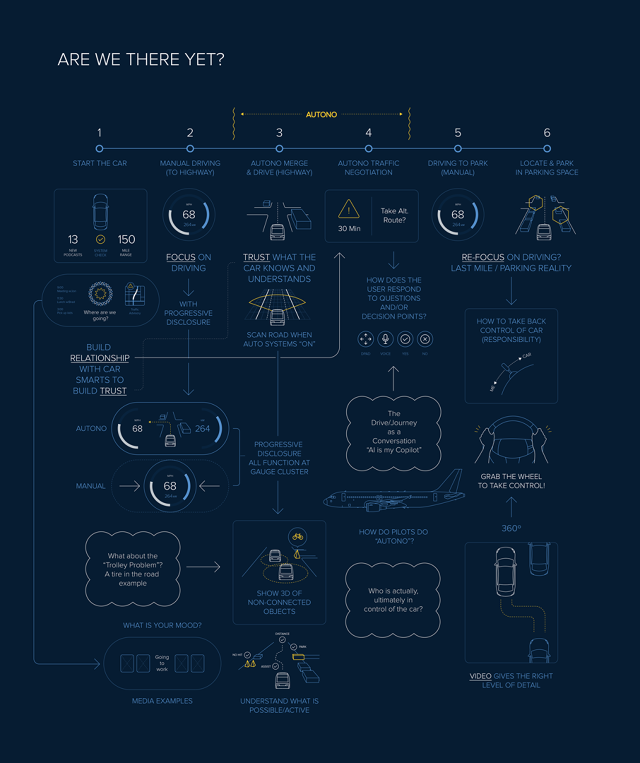When Tesla released a software update earlier this month that gave its Model S electric cars a new self-driving AutoPilot mode, Elon Musk cautioned that drivers "should keep their hands on the wheel just in case." With good reason. Just a few days later, Model S owners began posting videos to YouTube, showing their Tesla's veering dangerously and making other strange decisions when using the beta software.
For Artefact, the incident proved three things. One: cars aren't ready to totally drive themselves. Two: even if they were, humans aren't ready to trust them yet. And three: before drivers are ready to totally cede control to their autonomous cars, the automobile industry will need to think long and hard on how design can be used to establish a trusting relationship between people and their cars. So Artefact partnered with Hyundai to come up with a UX roadmap of the near-future of semiautonomous vehicles.

Although the media likes to fantasize about a tech company like Google or Apple just dropping a completely self-driving car on the market in the next few years, Artefact thinks that's unlikely to happen. They see fully autonomous vehicles as being 20 to 35 years away from mainstream acceptance. In the meantime, we will have what Artefact calls semiautonomous vehicles: increasingly intelligent cars with limited autonomous modes that can handle some things, but which will still require the user to take the wheel occasionally.
What makes the next couple decades so pivotal to auto manufacturers is that this is the crucial time period to convince consumers that their cars can make good driving decisions, and keep passengers alive. Establishing that trust will hinge upon new interfaces, new affordances, and new systems designed to transparently communicate when a semiautonomous vehicle does something unexpected (and why).
Playing along with the guidelines of its UX Roadmap, Artefact imagined a new Hyundai flagship semiautonomous vehicle, the Genesis, which would have the ability to drive itself. To turn on the Genesis's autonomous mode, a driver would push the wheel in, literally "handing the wheel" to the car. When this happens, the entire interface adapts, exposing only the information that is needed.
A key aspect of the Genesis concept is once the vehicle is in self-driving mode, the dashboard interface adapts to show a wireframe view of what the car sees as it is driving, with potential hazards marked in red. And if, for example, the car needs to suddenly swerve in response to a reckless cyclist, the dashboard would also clearly show the reason why the Genesis made this decision. Similarly, if the Genesis needs to reroute for any reason—say, to avoid a traffic accident on the highway—a message would be pushed to the dash, explaining why and forecasting a new arrival time.
Such transparency is important, because as the Tesla Autopilot beta shows, one of the challenges facing semiautonomous vehicles is the algorithms by which they make decisions is largely invisible to the driver. And in an era where VW is falsifying performance metrics, invisibility is not fashionable right now. If something unexpected occurs, the driver can only speculate what happened. That inscrutability is antithetical to developing trust, Artefact says. That's why an autonomous vehicle needs to be transparent about what it sees, what it intends to do, and why. But it's also important not to burden a driver with too much information, making the idea of turning over the wheel to the car intimidating.
Another key element to establishing trust is feedback. It's important for drivers to be able to influence their car's decision-making process, in case it behaves in autonomous mode in way that makes them uncomfortable. For example, perhaps your car knows traffic is bad on the highway you want to take, so it reroutes you down a quicker, but much bumpier and less scenic road. In an instance like that, the driver must be able to give feedback to the car, asking it to never take that diversion again, or ask for confirmation of future route changes.
In other words, before the cars of the future can become our pilots, they need to prove themselves as our co-pilots. According to Artefact, that's why the next few years are going to be huge for the automotive industry, as they slowly test and perfect the design principles that will define a future of cars where human drivers are optional.
You can read more about Artefact's case study here.